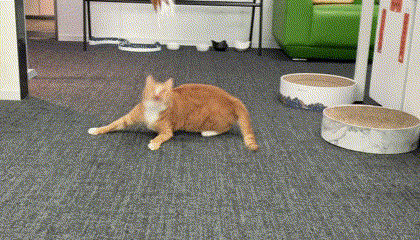-
At Least 15–20 Minutes Per Cat
In addition to meeting the required playtime, there are some important details to consider: A study from Tennessee, USA, in 2014 found that wild cats can chase prey at top speed for less than a minute, after which they need several hours to recover before they can hunt again. Cats are built for short bursts of energy. As a result, getting cats to do sustained aerobic exercise is difficult—it doesn’t align with their natural instincts, body structure, or energy consumption patterns. Therefore, when playing with your cat, it’s best to play for 5–10 minutes, followed by 5–10 minutes of rest, before starting the next round of play. With the rest intervals included, the total interaction time should generally be ≥30 minutes.
-
Separate Playtime for Multiple Cats, at Least 15 Minutes Each
For cats, play is a simulation of hunting. It helps them practice hunting skills, accumulate experience, and improve their success rate. Playtime habits are therefore similar to hunting habits—they’re solitary and don’t involve cooperation. This explains why, in multi-cat households, when you try to use a single toy like a cat teaser for several cats at once, one or more cats may hesitate and not fully engage. When playing with multiple cats, make sure to give them time to rest in between. You can start with one cat, and while it’s resting, play with another. If one cat is more playful or tends to grab the toy, you may need to separate them by room or time, alternating the play sessions.

-
Choose the Right Time and Vary the Play Options
As mentioned earlier, playtime for cats mimics hunting. The best time to engage in play is when wild cats are most likely to go hunting, which typically occurs in the early morning (can be replaced by parkour or running games), at dusk, and at night. The last two times are the ideal for play sessions. In addition to choosing the right time, it’s essential to provide a variety of interactive toys and activities to ensure high-quality playtime. According to the American Pet Products Association, cats have an average of 7 toys, including interactive toys (like cat teasers), solo toys (like sound-emitting mice with catnip), hide-and-seek toys (like tunnels), scratching toys (like cat scratchers), and food enrichment toys (like slow feeders). Offering a variety of toy types allows your cat to choose the activities they enjoy the most, encouraging more interaction and fulfilling their natural instincts.
-
What Happens If Playtime Is Inadequate?
Lack of time, being too tired, or cats not cooperating… we all have days when we slack off. But for cats, play is part of their nature—it’s as essential as eating, drinking, and using the litter box. A 2023 study from the University of Sussex and Northumbria University found that cats who didn’t get enough playtime with their owners were 4.2 times more likely to get into fights outdoors. A 2014 study from the BC SPCA (Vancouver Animal Shelter) confirmed that positive interaction during times of depression and anxiety can help relieve a cat’s stress.
In other words, your playtime with your cat can help alleviate the boredom of being home alone all day—it could be the highlight of their day that they’ve been looking forward to! So, never “half-heartedly” engage with them, and definitely don’t take away their joy…





